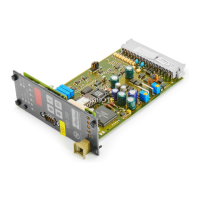26
IA VRD UK.INDD RH 02.06
Digital Power Amplifier
Series VRD350 and VRD355Installation Manual
Parker Hannifin GmbH & Co. KG
Hydraulic Controls Division
3.9. Step Function
A step-like command signal is added in control
loops with spool valves to overcome the control
edge overlap. The step function can be adjusted
with parameter P7 in the negative range (solenoid
A) and with parameter P8 in the positive range
(solenoid B). Valves overlaps are normally around
10% to 15% of FS. The setting has a decisive ef-
fect on the quality of positioning for axis drives. The
amplification in the small signal range is essentially
determined by the step function. In the case of open
loop valves, the preset value is directly applied as
a current. In the case of valves with spool position
feedback, the step function should be understood
as an additional position command signal. The cur-
rent is then adjusted accordingly to reach the speci-
fied position. When changing between open loop
and closed loop valves different command signals
may be necessary to achieve the same effect.
3.10. Control Circuits
(only with boards for closed loop system)
Feedback Signals and their Adjustment
The control can be activated or switched off with
E2. Feedback signals (0...10V, 0...±10V, 0...20mA
and 4...20mA) can be connected to terminal 10d.
For valves with spool position feedback using LVDT,
two settings for asymmetric signals are available
(6V ±2V or 7.5V ±2V). The selection of the ap-
propriate signal type is done in the software with
parameter E11.
Selections 7 to 9 are for external pressure control
loops using pressure control valves with only one
solenoid. In these cases, the software limits U13
to the positive range (solenoid B).
Selections 1 and 5 are for valves with spool position
feedback using LVDTs (see page 11 for standard
connections using directional control valves).
Selections 2 to 4 and 6 are for external control
loops using directional control valves and suitable
feedback transducers. For selections 1 to 6 U13
can be positive or negative, depending on the
difference between feedback and set value. Then,
either solenoid A or B is energized.
3.11. To set Zero Point
General Case
Place the feedback transducer in its zero position
(see table 25/1) and set the amplifier to display U11.
Then set the displayed value to zero by adjusting
potentiometer R12 (enable must be switched on,
remove the solenoid connector). If E11 = 7, 8, 9,
no values < 0.000 are shown.
With Position-ControlIed Valves
Set initial currents (P9, P10) and then set E2 = 0
(control system not active). Switch on enable and
leave solenoid plug connected. Now bring actual
value transducer into zero position and switch
amplifier over to display U11. Now set display U11
to zero with potentiometer R 12.
For setting the Range of the Feedback Signal
or setting the Feedback Gain
Adjust the feedback signal to its maximum value
for the particular transducer type. Set the gain with
potentiometer R11 so that display U11 on the ampli-
fier shows 9.90. These basic settings are carried out
in the factory for amplifiers ordered according to the
model codes. The feedback signal can be inverted
with parameter P12, and the set value signal with
P11, to change to a required control sense.
The actual value signal is now available at terminal
10b as an independent „display amplification value“
(e.g. for externally calibrated display functions).
The adjustment is made independantly of the real
actual value gain. The following adjustments then
should be made:
• Leave maximum value of actual value signal set
(see standardising the actual value signal)
• Now adjust potentiometer R13 so that the de-
sired value is present at terminal 10b (e.g. 6 V
for 60 bar).
E3 = 5 0.8A solenoid; NG06 proportional
valves, pressure valves, flow control
valves
E3 = 7 2.7A solenoid; NG06 high-response
directional valves (RLL)
To distinguish between current and voltage feed-
back signals, jumper X7 on the feedback option
board must be set correctly (see page 11). The
shunt has a resistance of 100 Ohms. In case it is
necessary to shift the zero level, this can be done
by the feedback circuit using potentiometer R12
(not possible for E11 = 3; 4; 6; 8 and 9).

